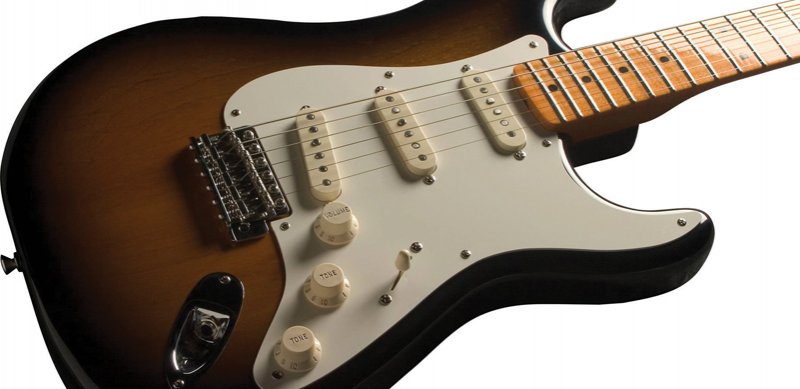Gear Review: Fender Eric Johnson Signature Stratocaster
Gear Review: Fender Eric Johnson Signature Stratocaster
Top-line guitarists are quirky individuals and highly creative in their approach to both music and the tools they make it with and there is almost invariably a greater or lesser degree of tinkering and customisation that goes into off-the-shelf name guitars. This month’s review model, the Eric Johnson Signature Stratocaster (rrp $3699), is a beautiful example of how the cumulative effect of a number of small modifications can make a sizeable difference to the sound of an already nice instrument.
Eric Johnson is something of a legend in guitar circles, not only for his brilliant and articulate playing across a number of genres, but also as a total perfectionist tone-hound who goes to extra-ordinary lengths to ensure that every facet of his tone remains unsullied by any acoustic, electronic or engineering imperfections.
Here’s a for instance. Eric claims to be able to hear an improvement in tone when the tremolo spring back cover is left off, so the EJ Strat likewise dispenses with this seemingly innocuous bit of aesthetic plastic. If, like me, you think that’s taking things a bit far, you can have a cover retro-fitted by an authorised Fender service agent. (There are no screw holes.)
In the quest for ultimate tone this guitar is finished in a thin layer of nitro-cellulose lacquer, an old-school natural finish that was common to vintage instruments before the heavier polyester-based systems replaced them. Although not as hardy as polyester, evidently the nitro-cellulose has superior tonal properties and will make the guitar sound even better as it ages. I wasn’t particularly taken with the single ply scratch plate, which looked like it had been cut out of ice-cream container plastic, but doubtless EJ had done his acoustic homework here as well.
The body, which is on the light side by Strat standards, is made from two pieces of weight-selected alder and features the deep back contouring that was a feature of one of Erics favourite instruments. The neck, which starts as a gentle V at the nut and morphs into a wide C shape at the 12th fret, is quarter-sawn hard rock maple with a 12 radius (pretty flat, more akin to a Les Paul) and comes with a real bone nut. What manner of animal donated its skeleton to this feature we may never know, but I’m sure Eric had a say in that too!
An interesting feature of the headstock is the absence of a string tree to hold the strings hard against the nut – achieved instead by a deeper routed headstock face and staggered vintage-style tuning keys – thus reducing string drag at the headstock and improving tremolo and tuning accuracy. Another small but cumulatively important part of the tone-quest puzzle is Erics requirement that the string access holes in the tremolo block be precisely drilled to a shallower depth.
 Pickups are, of course, the biggest contributors to a guitars tone and Eric has been characteristically thorough and idiosyncratic in his choices here. The neck pickup is based on the ’54 Strat with oversize Alnico 3 magnets, the middle is based on a ’63 Strat with specially treated (they don’t say how) Alnico magnets and is wound for hum cancellation when used with the neck or bridge pickups, the latter using Alnico 5 magnets and being voiced a little hotter than a standard Strat pickup without sacrificing sparkle.
Pickups are, of course, the biggest contributors to a guitars tone and Eric has been characteristically thorough and idiosyncratic in his choices here. The neck pickup is based on the ’54 Strat with oversize Alnico 3 magnets, the middle is based on a ’63 Strat with specially treated (they don’t say how) Alnico magnets and is wound for hum cancellation when used with the neck or bridge pickups, the latter using Alnico 5 magnets and being voiced a little hotter than a standard Strat pickup without sacrificing sparkle.
The wiring has naturally not escaped Eric’s penetrating gaze, with some simple but excellent mods that I reckon are quite superior to the stock configuration. The standard Strat’s bridge pickup normally has no tone control, this being reserved for the front and middle pickups, which, for me anyway, usually see considerably less action when soloing than the more incisive bridge pickup. It’s a very trebly beast that you can’t do anything to change, whereas the middle pickup – well I can’t ever remember feeling the need to roll off the tops.
Eric, it seems, agrees and his simple solution was to allocate the two tone controls to the neck and bridge pickups. It’s made a huge difference to the effective tonal range of the guitar – you can dial in an amazing piping tone to your bridge pickup lead playing that is totally inaccessible to a conventionally-wired Strat.
Before even plugging it in I was immediately impressed by the acoustic sound of the EJ – precise, even, sustained and tight-feeling, though having spent so long playing a standard radius Strat neck the flat feel took a little getting used to. In keeping with Erics quest for purity of tone I decided to leave all the effects and tone-sapping connectors in the bag and plug straight into my valve Laney to better get a gauge on the tonal heart of this deceptively straight-looking Strat.
The Eric Johnson Signature Strat may look like a million other Fenders, but it sounds like no other I’ve ever come across. That slightly hotted-up bridge pickup has plenty of punch but also warmth to go with it – vintage without the scratchy treble that turns off a lot of players. The out-of-phase positions two and four on the five-way selector were also something of a revelation – much meatier than I expected, as close to a humbucker sound as a single-coil Strat will get, with that trademark funky quack less in evidence.
The middle pickup, wired with the tone wide open, was voiced beautifully to carry out its job as the middle man, as at home playing choppy rhythm as it was punchy blues lead. The 54 –based neck pickup is likewise sweetly voiced, round, full and punchy without being overly bass-heavy, and proved to be extremely responsive to the tone control.
After all the trial and error, re-engineering, sourcing of vintage specd copper wire, variations in windings and magnets and whatever other contortions the Fender custom gurus had to go through to deliver the Eric Johnson vision of tonal perfection, I can only say it was all thoroughly worthwhile. The effort has resulted in a unique, tonally versatile and finely crafted guitar that shows all the benefits of decades of refinement by one of the most talented, dedicated and perfection-seeking minds in the business.
